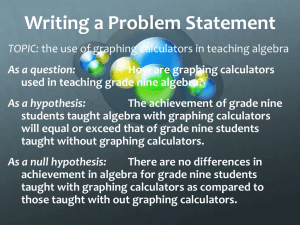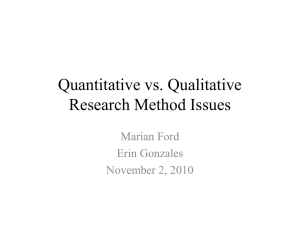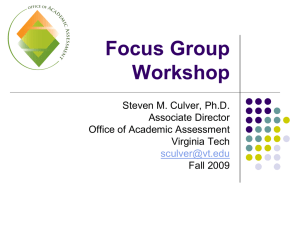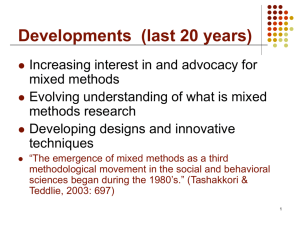Mixed Methods Research - University of Manitoba
advertisement
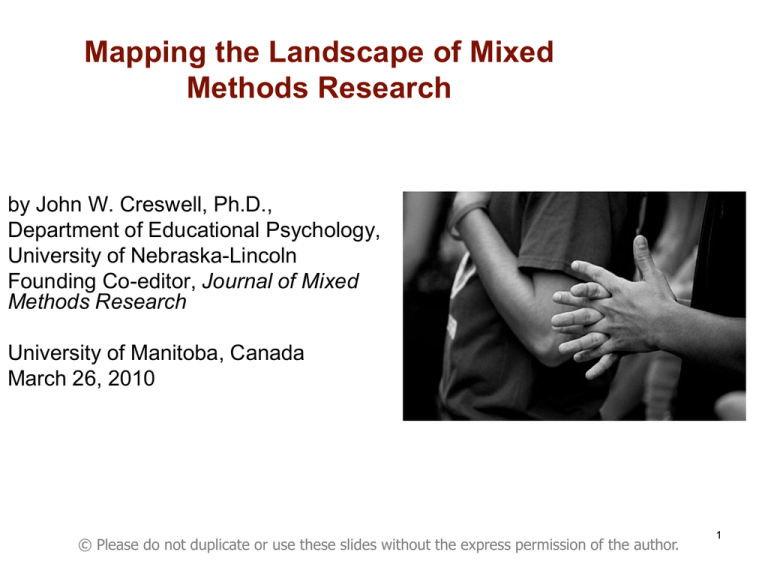
Mapping the Landscape of Mixed Methods Research by John W. Creswell, Ph.D., Department of Educational Psychology, University of Nebraska-Lincoln Founding Co-editor, Journal of Mixed Methods Research University of Manitoba, Canada March 26, 2010 © Please do not duplicate or use these slides without the express permission of the author. 1 Positioning Myself View research as set of interactive components; not always linear Focus on rigorous data collection and analysis Applied research methodologist Often work with individuals in a step-by-step process First generation mixed methods researcher I am still learning how to discuss/think about this topic How Do We Understand the Social World and Social Life? Quantitative methods Trends, graphs, statistics Cause-and-effect (factors that influence) Comparison of groups Frames study using theory Qualitative methods Individual stories Different perspectives Complexity of situation Builds up to a theory 4 The Al Gore Documentary on Global Warming 5 Stories and Trends Whitechuck Glacier 1973 Whitechuck Glacier 2006 6 The Story of Mixed Methods Research How mixed methods began and initially developed has become defined grew in philosophical ways developed technically became a “movement” has come under criticism continues to evolve as a methodology HOW MIXED METHODS RESEACH DEVELOPED AND IS DEFINED How, when, and why did mixed methods begin? How? Evolved over last twenty years Quantitative research to qualitative to mixed methods When? Beginnings in 1988-1989 Jennifer Greene – USA- University of Illinois - evaluator John Hunter and Allen Brewer – USA -Northwestern and Boston College sociologists Alan Bryman - England – management John Creswell – USA – education – my chapter on combining, my teaching of proposal development class – lst generation Fielding – sociologist in UK Why? Legitimacy of qualitative research Increased interest in having two strands – quan and qual – in studies Individuals looking for new methodologies What emerged? Quantitative Data Qualitative Data Mixed Methods Method Paradigm Perspective Methodology Using mixed methods in other designs 10 Six core characteristics of mixed methods research The collection of both qualitative and quantitative data (open- and closed-ended) in response to research questions The analysis of both qualitative and quantitative data Persuasive and rigorous procedures for the qualitative and quantitative methods The integration of these two data sources (merging, connecting, embedding) The use of a specific mixed methods design that involves a concurrent or sequential integration (and equal or unequal emphases) An approach to research that has a philosophical foundation 11 “Mixing” the two types of data… timing, implementation, priority Converge data: Qual Results Quan Connect data: Qual Quan Results Embed the data: Quan data Qual data 12 Typical Scenarios: Surveys and focus groups data are merged and compared. Survey is first completed and then focus groups used as a follow-up to explain the quantitative results. Focus groups are first conducted. Information learned is then used to construct an instrument for a follow-up with a random sample. An experiment is conducted and qualitative data are collected before the experiment begins and after the experiment has concluded. A longitudinal study is underway with multiple studies organized to address a single overarching research objective. The studies are both quantitative and qualitative . A primer on quantitative research Researcher makes decisions before study (variables, hypotheses, instruments) Researcher reduced the inquiry to a small number of variables to study and a large number of people Researcher asks specific closed-ended questions Researcher analyzes numbers Researcher places importance on reliability, validity, generalizability, replicability, control, and lack of bias Researcher writes the report using a standard structure 14 A primer on qualitative research Researcher makes decisions based on views of participants Researcher opens the inquiry up to understand the complexity of the situation Researcher asks open-ended questions – single phenomenon Researcher analyzes words and images Researcher places emphasis on individual meaning, context, and self-reflexivity Researcher writes the report using a flexible, literary structure 15 Reasons for “mixing” The insufficient argument – either quantitative or qualitative may be insufficient by itself Multiple angles argument – quantitative and qualitative approaches provide different “pictures” The more-evidence-the-better argument – combined quantitative and qualitative provides more evidence Community of practice argument – mixed methods may be the preferred approach within a scholarly community Eager-to-learn argument – it is the latest methodology “Its intuitive” argument – it mirrors “real life” PHILOSOPHICAL DEVELOPMENTS Four paradigm perspectives Postpositivism Determination Reductionism Empirical observation and measurement Theory verification Constructivism Understanding Multiple participant meanings Social and historical construction Theory generation Advocacy/Participatory Political Empowerment issueoriented Collaborative Change-oriented Pragmatism Consequences of actions Problem-centered Pluralistic Real-world practice oriented 18 What are the paradigm stances in mixed methods? Paradigms cannot be mixed – hence mixed methods is untenable (“incompatibility” thesis) Multiple paradigms can be used – but they need to be explicit and honored – and they lead to new insights (“dialectic” – Greene, 2007) Multiple paradigms can be used and they relate to design and stages in the research (Creswell and Plano Clark, 2007) There is one paradigm for mixed methods (pragmatism or transformative – Tashakkori and Teddlie, Mertens) The paradigm to use is based on the researcher’s community of scholars (Morgan) 19 The fit between paradigm and designs stance (Creswell & Plano Clark, 2007) Postpositivist Paradigm Survey Constructivist Paradigm Focus Group Interviews THE DEVELOPMENT OF TECHNIQUES Technique Developments Types of designs; diagrams, detailed procedures, notation Scripts for purpose statements Mixed methods research questions Analysis strategies for merging data Point of interface strategies for sequential data 22 Types of Mixed Methods Designs Concurrent Mixed Methods Designs Convergent Parallel Design QUAN Data & Results Interpretation QUAL Data & Results Embedded Design QUAN Pre-test Data & Results Intervention qual Process QUAN Post-test Data & Results Interpretation 23 Sequential Designs Mixed Methods Designs Explanatory Design QUAN Data & Results Following up qual Data & Results Interpretation Exploratory Design QUAL Data & Results Building to quan Data & Results Interpretation Sequential Embedded Design Beforeintervention qual QUAN Intervention Trial Afterintervention qual Interpretation 24 Emancipatory Theory Design A Framework (Participatory action research, community health research, critical theory, case study, narrative study, experimental study, etc. ) QUAL Data & Results Building to quan Data & Results Interpretation OR QUAN Data & Results Interpretation QUAL Data & Results 25 Multiphase (or Multi-project) Design QUAN Data & Results QUAL Data & Results Interpretation quan Data & Results QUAL Data & Results Interpretation Building to 26 Detailed diagram 27 28 Write a Purpose Statement for a Convergent Design Intent Design Data Purpose Rationale This mixed methods study will address _________________ (overall content-aim of the study). A convergent mixed methods design will be used, and it is a type of design in which different but complementary data will be collected on the same topic. In this study, _________________ (quantitative instruments) will be used to test the theory of _____________ (the theory) that predicts that __________________ (independent variables) will influence ________________ (positively, negatively) the __________ (dependent variables or outcomes) for ____________ (participants) at __________ (the research site). Concurrent with this data collection, qualitative _______________ (type of qualitative data, such as interviews) will explore ____________ (the central phenomenon) for _________________ (participants) at _____________(site). The reason for collecting both quantitative and qualitative data are to bring together the strengths of both forms of 29 research to ___________________ (e.g., compare results, validate results, corroborate results). A new type of research question: A mixed methods question Three ways to write this question: Methodologically-focused: To what extent do the qualitative results confirm the quantitative results? Content-focused: How do the interviews with adolescent boys support the quantitative results that their self-esteem changes during the middle school years? Hybrid of quantitative and qualitative elements: What results emerge from comparing the exploratory qualitative data about boy’s self-esteem with outcome quantitative instrument data measured on a self-esteem instrument? Example of Joint Display (Li, Marquart, & Zercher, 2000) 31 Example of Joint Display (Lee & Greene, 2007) 32 Point of interface strategies in sequential designs Exploratory Sequential Design = developing and testing an instrument Phase I QualitativeExploring a topic Phase II Developing an instrument Quotes=items Codes =variables Themes=scales Phase III Administering the instrument Testing psychometric properties 33 THE “MOVEMENT” OF MIXED METHODS RESEARCH 34 Describing mixed methods as a “movement.” “The emergence of mixed methods as a third methodological movement in the social and behavioral sciences began during the 1980’s.” (p. 697) -Tashakkori & Teddlie (2003) 35 Tracking empirical studies… Selected Mixed Methods Studies in Trauma Research (Creswell & Zhang, in progress) Authors (Year) Journal Topic Quan Data Qual Data Integration Impact Factor Jones, Kafetsios (2005) Clinical Child Psychology and Psychiatry Political Violence and Psychological Well-being HTQ and HSCL-25 Open-ended questions and observations Quan results are explored in a qual followup 4.434 Monneuse et al. (2008) Journal of the Surgeons Attitudes about Injury among High Questionnaire School Students Open-ended questions Quan results are explored in a qual followup 3.101 Evans et al. (2007) Journal of Traumatic Stress Intrusive Memories Related to Violent Crime Semi-structured interview Semi-structured interview Quan results are explored in a qual follow-up and vice versa 1.884 Yassi et al. (2004) Nursing Research Factors Associated with Staff Injuries Telephone survey Interview and focus group Qual findings help to develop or select quan instruments 1.748 Feeney, Ylvisaker (2003) Journal of Head Trauma Rehabilitation Context-Sensitive Behavioral Supports for Young Children with TBI MAS and ABCI Interview of openended questions Quan results are explored in a qual followup 1.643 Banyard, Williams (2007) Child Abuse & Neglect Women’s Voice on Recovery from Child Sexual Abuse Structured Interview In-depth, openended interview Quan results are explored in a qual followup 1.506 Igreja et al. (2006) The Journal of Nervous and Mental Disease Women’s Posttraumatic Suffering After the War HTQ and SRQ In-depth interview Comparison of the data sources 1.496 Arditti (2003) Journal of Loss and Trauma Family Visiting at a Local Jail Semi-structured interview Semi-structured interview Quan results are explored in a qual followup and vice versa 0.528 Gaskell (2007) Developmental Neurorehabilitation Evaluating Rehabilitative Activity Holidays for Burn-injured Children SDQ and Selfperception Profile for Children Qual questionnaire Comparing the data sources NA Noting books available… 37 MIXED METHODS CONFERENCE Programme 2008 www.mixedmethods.org Cambridge University, UK Seeing the development of mixed methods conferences… Noting journals devoted to mixed methods research… Founding Editors: John W. Creswell and Abbas Tashakkori Current Editors: Max Bergman (Switzerland), Donna Mertens (USA) 39 Additional mixed methods journals… Field Methods Quality and Quantity Multiple Approaches to Research (on-line) Other journals that publish mixed methods studies (e.g., International Journal of Social Research Methodology) Special issue journals CONTROVERSIES 41 Eleven key controversies (Creswell, in press) How should mixed methods be defined? Does the use of “quantitative” and “qualitative” in mixed methods create an artificial and unnecessary binary distinction? What is driving the interest in mixed methods? Is mixed methods a “new” approach? Can we “mix” paradigms in mixed methods? Does mixed methods privilege post-positivism? Is there a dominant, meta-narrative discourse emerging in mixed methods? Should there be a bilingual nomenclature for mixed methods? Have we arrived at an understanding of the types of research designs in mixed methods? Is mixed methods claiming other designs as “their own” ? What is the value added by mixed methods beyond conducting a quantitative or a qualitative study? Source: Creswell, J. W. (in press). Controversies in mixed methods. In N. K. Denzin and Y. S. Lincoln (Eds.) SAGE handbook of qualitative research (4th ed.). Thousand Oaks, CA: Sage. Some Writing on the Controversies •Is there a post-positivist leaning to mixed methods? Howe, K. R. (2004). A critique of experimentalism. Qualitative Inquiry, 10, 42-61. Giddings, L. S. (2006). Mixed-methods research: Positivism dressed in drag? Journal of Research in Nursing, 11(3), 195-2003. Holmes, C. A. (2007). Mixed(up) methods, methodology and interpretive frameworks. Contributed paper for the Mixed Methods Conference, Cambridge, University, July 10-12, 2006. •Is there a dominant discourse in mixed methods research? Freshwater, D. (2007). Reading mixed methods research: Contexts for criticism. Journal of Mixed Methods Research, 1(2), 134-146. 43 Some questions I have heard at University of Manitoba • I am collecting both quantitative and qualitative data my study, but am not calling it “mixed methods.” Should I? • What skills are essential for conducting a mixed methods study? • I have the qualitative skills, but really I am not competent in quantitative research, can I conduct a mixed methods study? • You have not highlighted the importance of research questions that drive good research. Shouldn’t a person know their question before they choose their method? • Most journals in my field have a 3000 word limit. How can I publish my mixed methods study with such limitations?44 What will hold mixed methods back? Time/resources to conduct studies Lack of understanding the methodology Difficult to change research behaviors Disagreements within the mixed methods community What will push mixed methods forward? Discipline expansion - unique discipline adoption International expansion and cooperation - little “Atlantic gap,” little North American gap Increased graduate student interests Refinement and expansion of techniques More advocates (and more critics) The need for an empirical study of the value added by mixed methods to qualitative or quantitative Summary Mixed methods is a recent methodological development There are different philosophical stances We know the basic feature of this approach Many techniques for conducting mixed methods research have developed Mixed methods has grown into an interdisciplinary, world-wide movement Yet, critics have emerged, and challenges exist The future is positive, but there is much work left to be done Additional readings Books: Creswell, J. W., & Plano Clark, V. L. (2007). Designing and conducting mixed methods research. Thousand Oaks, CA: Sage. Creswell, J. W. (2008). Research design: Qualitative, quantitative, and mixed methods approaches (3rd ed.). Thousand Oaks, CA: Sage Publications. Greene, J. C. (2007). Mixed methods in social inquiry. San Francisco: Jossey-Bass. Mertens, D. M. (2005). Research methods in education and psychology: Integrating diversity with quantitative and qualitative approaches (2nd ed.). Thousand Oaks, CA: Sage Publications. Plano Clark, V. L., & Creswell, J. W. (2008). The mixed methods reader. Thousand Oaks, CA: Sage. Tashakkori, A. & Teddlie, C. (1998). Mixed methodology: Combining qualitative and quantitative approaches. Thousand Oaks, CA: Sage Publications. Tashakkori, A. & Teddlie, C. (Eds.) (2003). Handbook of mixed methods in social and behavioral research. Thousand Oaks, CA: Sage Publications. 48 Additional readings Articles and Chapters: Caracelli, V. J., & Greene, J. C. (1993). Data analysis strategies for mixedmethod evaluation designs. Educational Evaluation and Policy Analysis, 15 (2), 195-207. Creswell, J. W., Plano Clark, V. L., Gutmann, M., & Hanson, W. (2003). Advanced mixed methods research designs. In: A. Tashakkori & C. Teddlie (Eds.), Handbook of mixed methods in social and behavioral research (pp. 209-240). Thousand Oaks, CA: Sage. Creswell, J. W., Plano Clark, V. L., & Garrett, A. L. (2008). Methodological issues in conducting mixed methods research. In M.M. Bergman (Ed.), Advances in mixed methods research. London: Sage. Greene, J. C., Caracelli, V. J., & Graham, W. F. (1989). Toward a conceptual framework for mixed-method evaluation designs. Educational Evaluation and Policy Analysis, 11 (3), 255-274. Ivankova, N. V., Creswell, J. W., & Stick, S. (2006). Using mixed methods sequential explanatory design: From theory to practice. Field Methods, 18(1), 3-20. Morgan, D. L. (2007). Paradigms lost and pragmatism regained. Journal of Mixed Methods Research, 1, 48-76. Morse, J. M. (1991). Approaches to qualitative-quantitative methodological triangulation. Nursing Research, 40, 120-123. 49 Mapping the Landscape of Mixed Methods Research by John W. Creswell, Ph.D., Department of Educational Psychology, University of Nebraska-Lincoln Founding Co-editor, Journal of Mixed Methods Research University of Manitoba, Canada March 26, 2010 © Please do not duplicate or use these slides without the express permission of the author. 50




